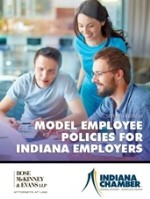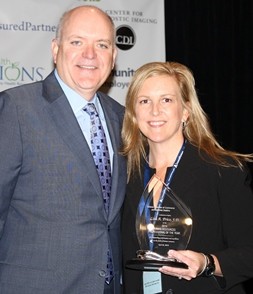 EDITOR’S NOTE: Anita Bunten was one of two winners of the 2015 Ogletree Deakins Human Resources Professional of the Year award. Nominations are open for the 2016 award through March 4.
EDITOR’S NOTE: Anita Bunten was one of two winners of the 2015 Ogletree Deakins Human Resources Professional of the Year award. Nominations are open for the 2016 award through March 4.
What is knowledge transfer? How important is it? If you have been a part of managing talent in your company for any period of time, you have heard this term. We all talk about it and think it is important, but do we know what it is and are we effective at facilitating it in our companies?
I, like many others, have used this term for several years. I have sat with our company leaders and discussed knowledge transfer, but not until I actually began to lay out a knowledge transfer plan for my own position did I realize how overwhelming it can be to actually be a part of true knowledge transfer.
We know how important it is to document everything we do – whether it is benefit plans, recruiting activities, employee relations or employee development. But our documentation does not generally include all of the knowledge that we as talent management professionals and leaders have retained while diligently working to support our company’s goals and take care of our company’s employees.
I realized very quickly as I put an onboarding plan together for someone to succeed me that while we document, there was a significant amount of historical “head” knowledge that was not documented. Some may have been documented but then purged over time. Knowledge transfer in its purest form is the “head” knowledge that we may share from time to time, but is not written or stored where others can easily access and/or use the information.
This knowledge is vital for our organizations, the staff who continue after we leave and our successors to continue the legacies and programs we leave behind. While change will come, this knowledge will assist others in making change decisions with a complete picture of why programs, policies and benefits are designed and set up as they are today.
So you may ask: How do you transfer this “head” knowledge to someone else? You could begin by manually recording every piece of information you can pull out of your brain storage bins. Of course, this would probably take you many months to actually put all of this information in a document. More than likely, you would have multiple documents and it would be difficult for someone in the future to truly absorb all that you had written. This also is probably not the most effective way because you are only pulling information out as you try to think back over time as to what might be important.
Another option is to hire someone to transcribe all of your thoughts. You can then review and edit what has been transcribed. After you spend an inordinate amount of time talking, reading and editing, you will still just have a large number of documents that will be difficult for anyone to truly absorb.
One important factor is missing in the two options listed above. That factor is you. While you may have tried to document everything you could possibly recall, there has not been any interaction with you to fully understand your limitless “head” knowledge. While documentation is extremely important, documentation does not provide the full understanding of why programs, policies and benefits are designed as they are today. You can also not effectively share “soft knowledge” in documents. Soft knowledge addresses the people, relationships, culture, land mines and so much more that can (and maybe should) only be shared in face- to-face conversations.
Given the above, I believe there are two important steps to effectively complete knowledge transfer. First, you need to make a list of all knowledge areas that are pertinent for someone succeeding you. This should not be a short list of categories, but a detailed list of anything and everything included in your responsibilities. While some items may not seem that important, the person new to your position does not want to be caught by surprise or learn at a later date that something fell through the cracks because you did not put it on this very important list. Examples of what you might consider minor could be an annual company cookout, how you handle birthdays for staff, do have you special reports you use periodically, how your company handles weather emergencies and the list goes on.
Second, you need to spend a significant amount of time with your successor, talking through all of the items on the list. I know your first question is how to do this when the overlap time from you leaving and your successor starting is often 30 days or less. It probably is not possible if you are leaving to accept another position or you are being asked to leave the organization. However, if you are retiring or leaving the organization in a situation where it is possible, you should make sure you give enough advance notice so that you have three to four months of overlap.
The first obstacle to this overlap will be your own personal fear of loss of ownership. This is an unfounded fear. If you are choosing to leave the organization and you want your legacy and passion for the employees to continue, it is essential that you be willing to share freely all of your “head” knowledge. As you take a successor through a well-designed onboarding program of all of your responsibilities, you will find that you will have the opportunity to share all of the historical information and nuances only you can effectively give. As I have continued to work with my successor, I cannot count the number of times I have said, “Let me give you a history lesson before we go into the detail,” or “let me talk with you about how you can effectively work with this person or through this type of situation in our company.”
The second obstacle is fear of sharing too early with your management your plans to leave. I can clearly relate to this because this was my greatest fear. I did not want my colleagues to think I was coasting. I did not want to be left out of future plan discussions. The list goes on, but if you plan to be an outstanding leader until you leave your company, your sense of responsibility and passion for your legacy and company employees require you to effectively plan for your departure and to give your management the time and opportunity to find a suitable replacement in order to allow the knowledge transfer to occur.
The third obstacle to this overlap will be cost. Your company may say that the overlapping salaries are too costly. I would challenge your management by saying the cost of not having a smooth transition with sufficient knowledge transfer will be more costly over time than three or four months of overlapping salary.
In the last three years, I have seen several high-level key employees leave our company. In one situation, the individual only gave about one months’ notice. While this individual left all of their paper and electronic records, they did not spend any time with their successor before they left. Even though the successor came from within our company, the successor has struggled because of the lack of “head” knowledge transfer and that very important soft knowledge.
In my situation, I will have three-and-a-half months to transfer “head” knowledge, including soft knowledge, to my successor. This is even more critical since my successor has come from outside the company. This overlap time has been invaluable to allow the individual the luxury of shadowing me and transitioning into the role while I am still here to provide the soft knowledge regarding people, relationships, culture, land mines and so much more that can only be shared in face-to-face conversations.
This type of knowledge transfer may not be as important if your company has a fully-developed succession plan for every position. My experience suggests to me that as hard as we try to have good succession plans, there are still transition periods and knowledge transfer periods for hand-picked successors, and there will be times when a successor is not in place at the time a transition is needed.
The effective transfer of “head” knowledge, including soft knowledge, is not just for our positions, but all positions in our companies. It is critical for continued and ongoing success of our companies. I encourage you to refine and/or implement plans within your companies to have effective knowledge transfer.
—
Anita R. Bunten is executive director of talent management at Indiana Farm Bureau Insurance Company (IFBI). She has spent her entire 40-year human resources career at the company. The HR Professional of the Year award is a statewide recognition given annually to those that provide lasting impact through the implementation of best practices, organization design and effectiveness and accomplishment of the company’s strategic direction.


 In 2014, President Obama directed the U.S. Department of Labor (DOL) to update and modernize rules regulating exemption of certain employees from minimum wage and overtime protection provisions of the Fair Labor Standards Act. Just a few weeks ago, the U.S. DOL released regulations regarding new rules for overtime. This action drastically increases the salary threshold under which most employees would be eligible for overtime pay, from $23,660 for a full-time employee to $47,476 per year. This will affect millions of middle-wage employers across the country.
In 2014, President Obama directed the U.S. Department of Labor (DOL) to update and modernize rules regulating exemption of certain employees from minimum wage and overtime protection provisions of the Fair Labor Standards Act. Just a few weeks ago, the U.S. DOL released regulations regarding new rules for overtime. This action drastically increases the salary threshold under which most employees would be eligible for overtime pay, from $23,660 for a full-time employee to $47,476 per year. This will affect millions of middle-wage employers across the country. The new seventh edition of our popular handbook,
The new seventh edition of our popular handbook,  The Indiana Chamber of Commerce announced today the 2016 recipient of the Ogletree Deakins Human Resources Professional of the Year award. Lisa Price, executive vice president of human resources at
The Indiana Chamber of Commerce announced today the 2016 recipient of the Ogletree Deakins Human Resources Professional of the Year award. Lisa Price, executive vice president of human resources at  The Successful Recipe for Disability Inclusion is a free, one-day training event for supervisors, hiring managers, HR professionals and business owners.
The Successful Recipe for Disability Inclusion is a free, one-day training event for supervisors, hiring managers, HR professionals and business owners. EDITOR’S NOTE: Anita Bunten was one of two winners of the 2015 Ogletree Deakins Human Resources Professional of the Year award.
EDITOR’S NOTE: Anita Bunten was one of two winners of the 2015 Ogletree Deakins Human Resources Professional of the Year award.  There are still more than one million veterans looking for full-time jobs with tens of thousands of soldiers leaving the military in 2016. Many employers aren’t getting the right information and networking help they need to successfully hire veterans, Reservists and National Guard members.
There are still more than one million veterans looking for full-time jobs with tens of thousands of soldiers leaving the military in 2016. Many employers aren’t getting the right information and networking help they need to successfully hire veterans, Reservists and National Guard members.

